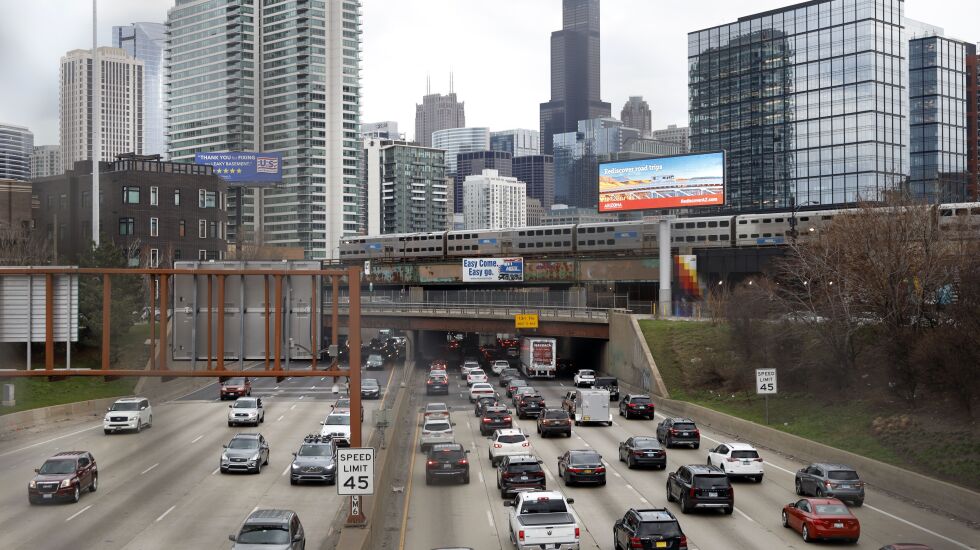
It was nice to get out more last year after the pandemic forced us to stay inside for most of 2020.
Getting behind the wheel to hang out with friends or for out-of-state road trips felt like a blessing for many vaccinated Americans who felt safer in public.
But the 325 billion more miles driven came with a tragic price. Nearly 43,000 people were killed on U.S. roads in 2021, according to preliminary data released last week by the U.S. Department of Transportation’s National Highway Traffic Safety Administration.
The 42,915 traffic deaths were the highest number recorded in the country since 2005. Additionally alarming is that the 10.5% increase from the 38,824 traffic deaths in 2020 was the largest annual percentage increase since the NHTSA started collecting fatality data in 1975.
Illinois was among the 44 states that saw a rise in traffic deaths, with 1,357 in 2021 compared to 1,194 in 2020.
The statistics are unnerving and unfortunately come as no surprise. American motorists have been behaving more recklessly since COVID-19 upended our lives.
More drivers are speeding, hitting the road while intoxicated and choosing to keep their seatbelts off, according to the NHTSA, Governors Highway Safety Association and other agencies that monitor traffic patterns.
The seeds were planted in 2020 when many drivers glimpsed sparser traffic, fewer cops and wide-open roads, and thought they could take more risks without any consequences. So when traffic volumes returned to close to pre-pandemic levels in 2021, the dangerous driving trends continued, experts said.
Adding to that mix is the uptick of distracted driving. A 2021 Travelers survey revealed more motorists were texting, emailing, checking social media, shooting videos, snapping photos and shopping online than they were before the pandemic.
It’s as if the basic rules of the road have been thrown out the driver’s window.
Since most people aren’t going to retake the outdated driver’s education class they sat though in high school, here is a crash course in traffic safety: Slow down, snap on your seatbelt, stay off the phone, keep your eyes on the road and sober up if you’ve been drinking alcohol or taken any other drug. If you can’t do that, hand over the keys to a friend.
Law enforcement officials need to be more vigilant regarding dangerous infractions. No driver wants to get a ticket, but maybe that’s what is needed to shock them into safer driving and keep them from killing others — and maybe themselves.
Human error
There is widespread agreement that only a wholistic “safe system” — safer people, roads, vehicles, speeds and post-crash care — can help lower the number of deadly crashes.
Human error is only one piece of puzzle, but it is a big piece.
Dangerous driving “combined with roads designed for speed instead of safety, has wiped out a decade and a half of progress in reducing traffic crashes, injuries and deaths,” Russ Martin, GHSA’s senior director of policy and government relations, said.
If Martin’s comments aren’t enough to make motorists rethink their choices, the startling data should.
Drivers struck and killed 7,485 people on foot in 2021 — the most pedestrian deaths in a single year in four decades, a GHSA report issued Thursday revealed.
Within a year, pedestrian-related traffic fatalities increased by 13%, the NHTSA study also found.
The rest of the NHTSA’s data is just as troubling.
Traffic fatalities involving vehicles going well over the speed limit and police-reported alcohol-related crashes jumped 5% in 2021.
There was also a 3% increase in deadly wrecks in which the occupants of the vehicles were not belted in.
Crashes during out-of-state travel spiked 15% from the year before, multi-vehicle crashes jumped 16%, and fatalities among bicyclists and motorcyclists went up by 5% and 9%, respectively.
Those are just a few of the dismal findings that prompted U.S. Transportation Secretary Pete Buttigieg to point to the billions in traffic safety grants that will be available in the next five years to cities and towns under the Bipartisan Infrastructure Investment and Jobs Act’s new Safe Streets and Roads for All program.
The infrastructure law, signed by President Joe Biden last year, also includes several proposed recommendations that should make vehicles safer for pedestrians and bicyclists.
All worthwhile efforts that will save lives.
Every motorist must do his or her part, too. Slam the brakes on bad driving habits — and be a back-seat driver when necessary — to save lives.
Send letters to letters@suntimes.com.







